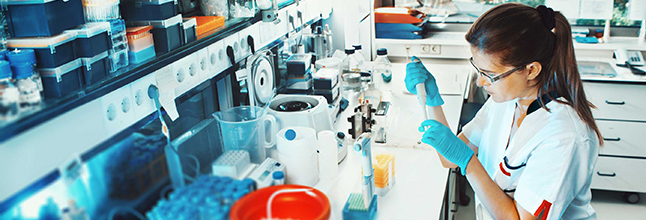Keeping the IV Room Free of Contaminants: Part II
In this two-part series, we will explore strategies to keep the IV room free of contamination, with a focus on electronic checklists. In Part I, discussed training checklists for keeping the IV room clean. In Part II, we will discuss daily, weekly and monthly checklists for keeping the IV room pollutant-free.
Cleanrooms require regular care to maintain cleanliness standards. This is important not only to optimize patient care but also to meet Joint Commission inspection standards. To this end, it is important to develop checklists for regular cleaning protocols. Generally, the cleaning takes place on a daily, weekly, and monthly basis, depending on the tasks. Different daily, weekly, and monthly checklists should be developed to address the different cleaning protocols required in these timeframes.
Basic Cleaning Principles
Checklists should include basic cleaning principles. Even if these principles seem obvious to trained staff, it is important to include them not only for new staff, but to reinforce existing training. For example, the checklist should specify that cleaning always starts in the cleanest area and moves to the dirtiest area in unidirectional overlapping strokes. This means that cleaning should start in an ISO Class 5 room and gradually move from ISO Class 6 to ISO Class 7 rooms. Further, the rooms should be cleaned from the back of the room towards the exits/door. In addition, checklists should include the order in which cleaning takes place, ceilings, walls/windows, equipment/furniture, bars and hooks, diffusers, work surface, underneath the work surface, and floors.
Depending on the cleaning agents that your facility uses, you may additionally consider itemizing manufacturer-specific cleaning recommendations on your checklist. For example, many manufacturers will specify a recommended contact time for the cleansing agent. Your facility may, therefore, consider specifying this recommended contact time on your electronic protocols. Alternatively, if your facility uses several different manufacturers for cleaning, you may instead choose to include instructions on your checklist to refer to the manufacturer’s instructions before cleaning.
Daily Cleanroom Maintenance
Most daily cleaning should be conducted at the end of the day after compounding is completed. However, an exception to this is workstation surfaces, which should be sanitized at the beginning of each compounding day. Often, daily cleaning is the responsibility of a designated inpatient pharmacy technician. If daily cleaning has not taken place or been appropriately documented, this should take place the next day before any compounding begins.
A sample daily cleaning checklist may include:
- Mix cleaning agents and update log
- Preclean heavily soiled areas as necessary to make cleaning agents more effective
- HEPA filter vacuum ceiling
- HEPA filter vacuum walls
- Decontaminate hood and all items used in compounding with an oxidizing agent like sodium hypochlorite or hydrogen peroxide, using low-lint wipes
- Following decontamination, clean all items used in compounding with a detergent, using low-lint wipes
- Following decontamination and cleaning, disinfect all items used in sterile compounding, using low-lint wipes
- Disinfect equipment and furniture with designated cleaning products, including sinks, counters, carts and cart tops, stools and stool tops, and sharps containers
- Damp mop floors with deionized water using a figure 8 pattern
- Dry floors with a HEPA filter vacuum after mopping
- Disinfect workstations with designated cleaning products
- Empty waste bins and replace waste liners
- Arrange removal of hazardous-waste receptacles
- Arrange removal of biohazardous waste receptacles
- Update cleaning agent log, noting any rotation of cleaning solutions
Weekly Cleanroom Maintenance
Weekly cleanroom maintenance can be similar to daily maintenance in many ways. However, additional items may be included that do not require daily attention. Weekly cleaning is often the responsibility of the pharmacist on duty or their designee. A sample weekly cleaning checklist may include:
- Test eyewash station prior to cleaning
- Mix cleaning agents and log
- Empty trash receptacles, replacing liners
- Arrange removal of hazardous-waste receptacles
- Arrange removal of biohazardous materials
- Mop floors utilizing a figure 8 pattern
- Clean windows, doors, and horizontal surfaces from top to bottom
- Clean hoods including doors, side, front, and back from top to bottom
- Decontaminate all items used in compounding with an oxidizing agent like sodium hypochlorite or hydrogen peroxide
- Following decontamination, clean all items used in compounding with a detergent
- Following decontamination and cleaning, disinfect all items used in sterile compounding
- Clean sinks, countertops, carts and cart tops, stools and stool tops, waste containers, and exterior of sharps containers
- Empty, clean, and sanitize storage shelving and storage bins
- Clean workstations with designated agents, noting any rotation of solutions
- Disinfect workstations with designated agents, noting any rotation of solutions
- Update cleaning log
Monthly Cleanroom Maintenance
Monthly cleanroom maintenance often includes additional elements on top of the typical daily and weekly cleaning schedule. Specifically, sporicidal treatments are often used on a monthly basis. In some cases, special cleaning teams at the facility may provide deep cleaning on a monthly basis on top of the daily or weekly cleaning that may be provided by regular pharmacy staff.
Of note, it is not required to do all monthly cleaning on the same day. Instead, monthly cleaning may be split up and done throughout the month.
A sample monthly cleaning checklist is as follows:
- Inspect spill kits to ensure presence and that they have not been used
- Mix cleaning and disinfecting agents including any recommended sporicide
- Wipe down waste bins with a sporicidal treatment
- Mop ceilings with a sporicidal treatment
- Mop walls with a sporicidal treatment
- Mop floors with a sporicidal treatment utilizing a figure 8 pattern
- Empty, clean and sanitize storage shelves and bins with a sporicidal treatment
- Clean hoods including doors, side, front, and back from top to bottom with a sporicidal treament
- Clean and sanitize both the inside and outside of refrigerators and incubators
- Clean workstations with designated agents, noting any rotation of solutions
- Disinfect workstations, noting any rotation of solutions
- Update cleaning log
It should be noted that specific cleaning protocols may vary per facility. This is based not only on the ISO levels of the facility, but also the specific items within the facility and the exact cleaning products used. However, development of a checklist to support staff cleaning protocols can help keep your facility safe and compliant with regulations.



